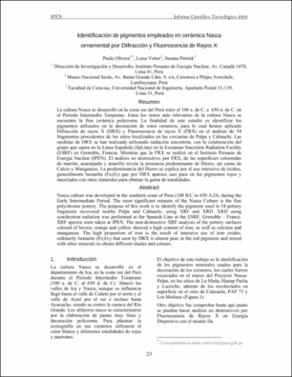Mostrar el registro sencillo del ítem
Identificación de pigmentos empleados en cerámica Nasca ornamental por difracción y fluorescencia de rayos X
| dc.contributor.author | Olivera, Paula | |
| dc.contributor.author | Vetter, Luisa | |
| dc.contributor.author | Petrick, Susana | |
| dc.creator | Petrick, Susana | |
| dc.creator | Vetter, Luisa | |
| dc.creator | Olivera, Paula | |
| dc.date.accessioned | 2016-09-07T20:32:01Z | |
| dc.date.available | 2016-09-07T20:32:01Z | |
| dc.date.issued | 2010-04 | |
| dc.identifier.citation | Olivera P, Vetter L, Petrick S. Identificación de pigmentos empleados en cerámica Nasca ornamental por difracción y fluorescencia de rayos X. Informe Científico Tecnológico. 2008; 8: 23-27. | es_PE |
| dc.identifier.issn | 1684-1662 | |
| dc.identifier.uri | https://hdl.handle.net/20.500.13054/580 | |
| dc.description.abstract | La cultura Nasca se desarrolló en la costa sur del Perú entre el 100 a. de C. a 650 d. de C. en el Período Intermedio Temprano. Entre los restos más relevantes de la cultura Nasca se encuentra la fina cerámica policroma. La finalidad de este estudio es identificar los pigmentos utilizados en la decoración de estos ceramios, para lo cual hemos aplicado Difracción de rayos X (DRX) y Fluorescencia de rayos X (FRX) en el análisis de 54 fragmentos procedentes de los sitios localizados en las cercanías de Palpa y Cahuachi. Las medidas de DRX se han realizado utilizando radiación sincrotrón, con la colaboración del grupo que opera en la Línea Española (SpLine) en la European Sincrotón Radiation Facility (ESRF) en Grenoble, Francia. Mientras que la FRX se realizó en el Instituto Peruano de Energía Nuclear (IPEN). El análisis no destructivo, por FRX, de las superficies coloreadas de marrón, anaranjado y amarillo revela la presencia predominante de Hierro, así como de Calcio y Manganeso. La predominancia del Hierro se explica por el uso intensivo de óxidos, generalmente hematita (Fe2O3) que por DRX aparece casi pura en los pigmentos rojos y mezclados con otros minerales para obtener la gama de tonalidades. | es_PE |
| dc.description.abstract | Nasca culture was developed in the southern coast of Peru (100 B.C to 650 A.D), during the Early Intermediate Period. The most significant remains of the Nasca culture is the fine polychrome pottery. The purpose of this work is to identify the pigments used in 54 pottery fragments recovered nearby Palpa and Cahuachi, using XRF and XRD. XRD using synchrotron radiation was performed at the Spanish Line at the ESRF, Grenoble, France. XRF spectra were taken at IPEN. The non-destructive XRF analyses of the pottery surfaces colored of brown, orange and yellow showed a high content of iron, as well as calcium and manganese. The high proportion of iron is the result of intensive use of iron oxides, ordinarily hematite (Fe2O3) that seen by DRX is almost pure in the red pigments and mixed with other minerals to obtain different shades and colours. | |
| dc.description.sponsorship | Organismo Internacional de Energía Atómica ( OIEA), Contrato de Investigación CRP PER/13058, “Applications of Nuclear Analytical Techniques to Investigate the Authenticity of Art Objects” | |
| dc.format | application/pdf | es_PE |
| dc.language.iso | spa | es_PE |
| dc.publisher | Instituto Peruano de Energía Nuclear | es_PE |
| dc.rights | info:eu-repo/semantics/openAccess | es_PE |
| dc.source | Instituto Peruano de Energía Nuclear | es_PE |
| dc.source | Repositorio Institucional del Instituto Peruano de Energía Nuclear | es_PE |
| dc.subject | Arqueología | es_PE |
| dc.subject | Muestras arqueológicas | es_PE |
| dc.subject | Análisis por fluorescencia de rayos X | es_PE |
| dc.subject | Difracción de rayos X | es_PE |
| dc.subject | Pigmentos | es_PE |
| dc.subject | Radiación sincrotrónica | es_PE |
| dc.subject | Cultura Nasca | es_PE |
| dc.title | Identificación de pigmentos empleados en cerámica Nasca ornamental por difracción y fluorescencia de rayos X | es_PE |
| dc.title.alternative | Identification by x-ray fluorescence and diffraction of pigments used in Nasca ornamental ceramic | es_PE |
| dc.type | info:eu-repo/semantics/article | es_PE |
| dc.publisher.country | PE | es_PE |





